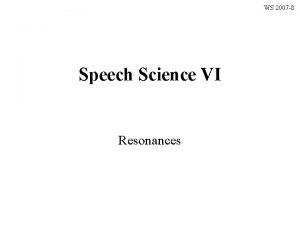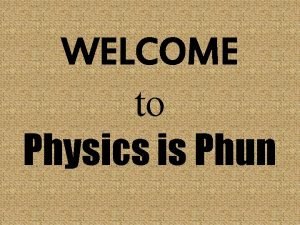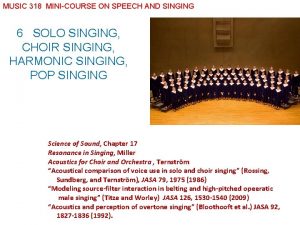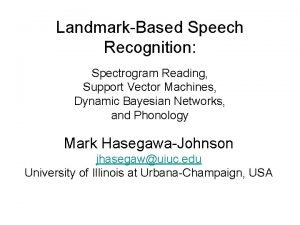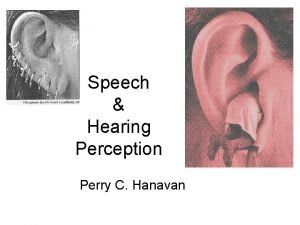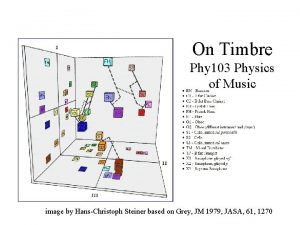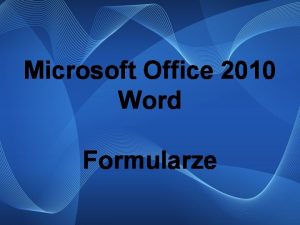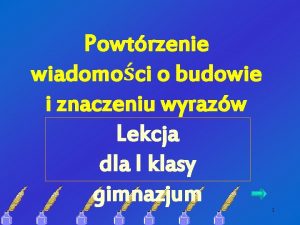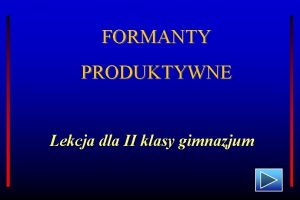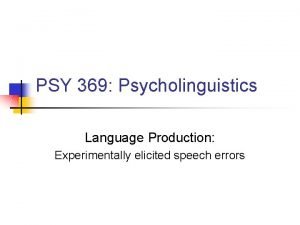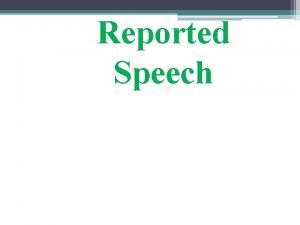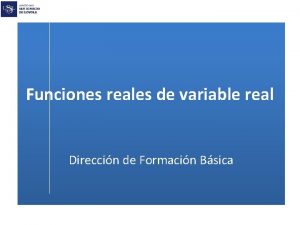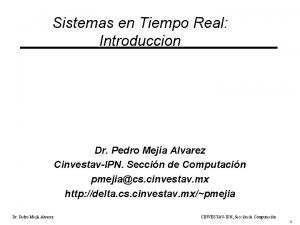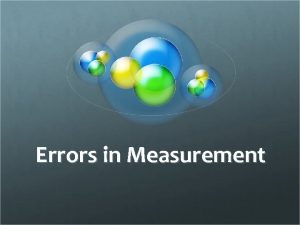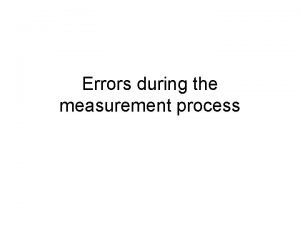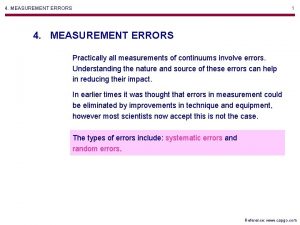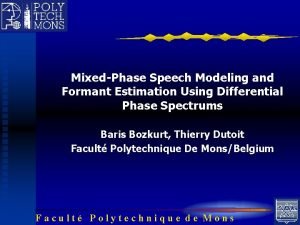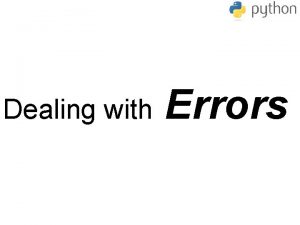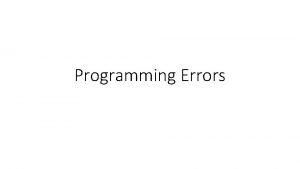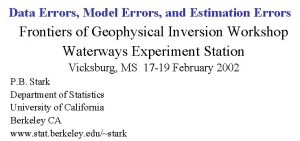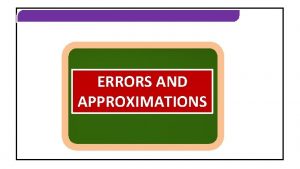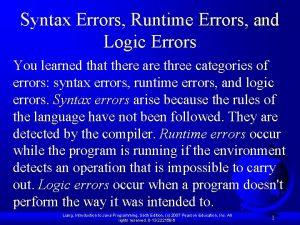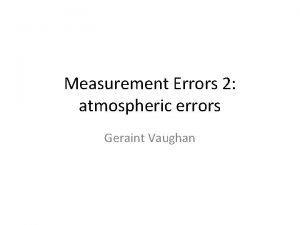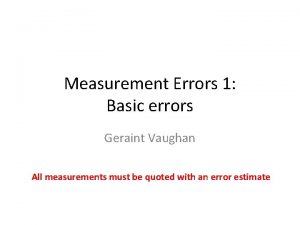Formant Measurement Errors From Real Speech Philip Harrison



















- Slides: 19

Formant Measurement Errors From Real Speech Philip Harrison J P French Associates & University of York IAFPA 20 th Annual Conference 24 th – 28 th July 2011 – Vienna

Outline • Motivation & background • Formant measurement errors from synthetic speech • Formant measurement errors from real speech – VTR database – Praat tracker – CAb. S tracker – Published results – MSR & Wave. Surfer l • Discussion 2 2

Motivation & Background • All measurements are subject to ‘error’ • An estimate of the error should accompany all measurements • Increasing use of formant measurements in forensic casework – no errors quoted 3 • Significant problem – can’t obtain ‘ground truth’ values from real 3 l speech to determine error of

Errors from Synthetic Speech • Idealised synthetic male speaker – 2, 858 monophthongs over F 1, F 2 vowel space – Specified F 1 to F 5 centre frequency & bandwidth – Pulse train glottal source, range of F 0 s (70 – 190 Hz) l • Measured formants at different LPC orders (6 to 20) in Praat – Burg (LPC) analysis, not a tracker • Calculation of error: Ferror = Fmeasured – Fspecified 4 4

Error Summary Results – Absolute Error @ F 0 = 100 Hz F 1 Abs (SD) Hz LPC 7 9. 6 (10. 4) LPC 8 8. 3 (8. 8) LPC 9 8. 8 (8. 7) l % 2. 1 (2. 3) 1. 8 (1. 9) 2. 0 (2. 0) F 2 Abs (SD) Hz 31. 6 (19. 4) 18. 3 (11. 6) 8. 0 (9. 2) % 2. 1 (1. 2) 1. 3 (0. 8) 0. 6 (0. 7) F 3 Abs (SD) Hz 99. 8 (36. 9) 41. 1 (17. 9) 10. 7 (8. 3) % 4. 2 (1. 4) 1. 7 (0. 7) 0. 5 5 (0. 3) 5

Multiple Synthetic Speakers l • Variation both within and between real speakers in many speech production parameters – e. g. F 0 range, F 1 -F 2 vowel space, formant bandwidths • Single synthetic speaker unlikely to be representative or capture variation 6 • Consider multiple synthetic speakers: 6 – Alternative specified F 3 values – 8

Multiple Synthetic Speakers – Summary Results • Alternative F 3 – Negligible influence on F 1, F 2 errors – Changes in F 3 error surface – influenced by F 3 surface – F 3 error dependent on location within F 1, F 2 space – constant F 3 speakers – high F 1 & F 2 -> larger F 3 errors • Glottal source signal l – Impact on error surfaces & performance – across all formants – some better, some worse than baseline 7 7

Real Speech • How do these results translate to real speech? • Can’t directly test real speech – reason for using synthetic speech initially • Compare overall performance of real and synthetic speech… 8 l 8

VTR Database l • Database of hand-corrected vocal tract resonance values (Deng et al 2006) – balanced subset of TIMIT corpus – good quality digital recs • 516 sentences – 186 speakers (113 male, 73 female) – 61, 000 vowel frames, 6, 600 vowel tokens • Similar method to synthetic speakers 9 but frame by frame measurements and token means across monophthongs & 9 diphthongs

VTR Results Frame LPC 15 Frame ♂ 17 Frame ♀ 14 Token 15 F 1 Abs 86 (124) 78 (108) 94 (141) 66 (89) % 17 (27) 17 (25) 17 (26) 14 (18) LPC 11 11 10 11 F 2 Abs 201 (301) 177 (259) 225 (331) 161 (220) % 13 (19) 12 (18) 13 (20) 10 (13) LPC 10 11 F 3 Abs % 217 9 (337) (14) 202 9 (306) (13) 228 9 (347)10 (14) 179 7 (249) (9)

Comparison with Synthetic Speech F 1 LPC Abs % Synth 8 Real l 8. 3 (8. 8) 17 63 (84) F 2 LPC Abs % 1. 8 9 (1. 9) 14 11 (19) 8. 0 (9. 2) 151 (205) F 3 LPC Abs % 0. 6 9 (0. 7) 10 11 (14) 10. 7 (8. 3) 168 (235) 0. 5 (0. 3) 7 (10) • Both speakers = male, monophthong token average 11 • Best performance of all real results shown 11

Can Results be Improved? l • Real speech results not as good as synthetic speech • But measurements so far made without any ‘intelligence’ in selection of values • Praat standard formant measurement tool is not a tracker • Formant trackers attempt to select most likely values based on criteria – bandwidth, centre frequency, frame 12 transitions 12

Trackers Tested • Trackers – Praat tracker – Viterbi algorithm, considers centre frequency, bandwidth and frame transitions – CAb. S tracker (Clermont et al 2007) – cepstral compatibility between original signal and candidate formants, plus continuity constraints • ‘Default’ settings used l 13 13

Praat Tracker Results Frame LPC 15 Tracker Frame Token 15 Tracker Token 15 15 F 1 Abs 86 (124) 55 (75) 66 (89) 46 (61) % 17 (27) 11 (17) 14 (18) 10 (14) LPC 11 11 F 2 Abs 201 (301) 94 (163) 161 (220) 81 (141) % 13 (19) 7 (15) 10 (13) 6 (12) LPC 10 14 11 14 F 3 Abs % 217 9 (337) (14) 179 8 (359) (19) 179 7 (249)14 (9) 162 8 (332) (18)

CAb. S Tracker Results Frame LPC 15 Tracker Frame Token 14 Tracker Token 14 15 F 1 Abs 86 (124) 69 (139) 66 (89) 62 (132) % 17 (27) 15 (34) 14 (18) 14 (33) LPC 11 13 F 2 Abs 201 (301) 122 (239) 161 (220) 115 (218) % 13 (19) 8 (18) 10 (13) 8 (16) LPC 10 12 11 11 F 3 Abs % 217 9 (337) (14) 413 18 (544) (25) 179 7 (249)15 (9) 414 18 (512) (23)

Tracker Comparison Frame Data Praat LPC 15 Praat Tracker 15 CAb. S Tracker 14 Wav. Surf MSR F 1 Abs 86 (124) 55 (75) 69 (139) 70 64 % 17 (27) 11 (17) 15 (34) LPC 11 11 13 F 2 Abs 201 (301) 94 (163) 122 (239) 94 105 % 13 (19) 7 (15) 8 (18) LPC 10 14 12 F 3 Abs % 217 9 (337) (14) 179 8 (359) (19) 413 18 (544)16 (25) 154 125

Discussion • Even with a tracker real speech results not as good as synthetic performance • But VTR database not perfect • Does allow comparison of trackers – no obvious ‘winner’ • Even though best performance at different LPC orders across F 1, F 217 & F 3, results similar enough to use l same LPC order for all formants 17

Further Questions… • What is the variation across speakers and vowel categories? Is it significant? • What is the maximum acheivable performance? • Is 10% error a realistic estimate? – Possibly test more diverse synthetic speech l • Is 10% error acceptable? • What impact does this have on LRs and other numerical analyses (LTFAs)? 18 • Are trackers accurate enough to be used unattended on large corpera? How 18 much manual intervention is necessary?

Questions ? Thanks to Frantz Clermont, Peter French & Paul Foulkes l References: Clermont, F. , Harrison, P. & French, P. (2007) ‘Formant-pattern estimation guided by cepstral compatibility’. Proceedings of IAFPA 2007 Annual Conference, Plymouth, UK. Deng, L. , Cui, X. , Pruvenok, R. , Huang, L. , Momen, S. , Chen, Y. and 19 Alwan, A. “A database of vocal tract resonance trajectories for research in speech processing, ” Proceedings of the IEEE International Conference on Acoustics, Speech, and Signal Processing (ICASSP), 19 Toulouse, France, May 2006.
 Picture of harrison bergeron
Picture of harrison bergeron Formant frequencies
Formant frequencies Formant frequencies
Formant frequencies Formant frequencies
Formant frequencies Formant frequencies
Formant frequencies Formant
Formant Timbre coloration glide or formant glide
Timbre coloration glide or formant glide Formularze word
Formularze word Dopisz wyrazy podstawowe i pochodne według wzoru
Dopisz wyrazy podstawowe i pochodne według wzoru Formant co to
Formant co to Language production
Language production He said i was playing football change speech
He said i was playing football change speech Funciones variables de variable real
Funciones variables de variable real The real real fashion copywriter
The real real fashion copywriter Sensor and (tiempo real or real time)
Sensor and (tiempo real or real time) Where are polynomials used in real life
Where are polynomials used in real life Ch 9 ream people real choice case study
Ch 9 ream people real choice case study Coca cola the real story behind the real thing
Coca cola the real story behind the real thing Marketing real people real choices
Marketing real people real choices Southpointe village apartments fishers in
Southpointe village apartments fishers in

